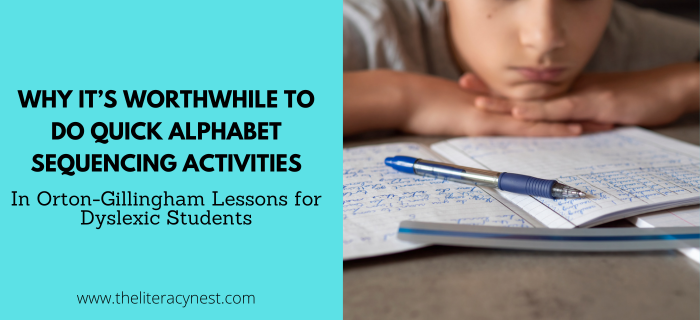Invitations to Accuracy in Your Orton-Gillingham Lessons
As Orton-Gillingham tutors, it is common to find that accuracy will decline a bit in certain parts of the lesson. When we take a closer look and ask why, we notice some patterns. A frequent place for accuracy to break down is during the dictation portion of the lesson. A student who may be quite confident reading word lists and sentences may experience some challenges when incorporating their knowledge with all the other components of writing. For other students, they may have a very high degree of accuracy at the word level, but struggle to maintain that accuracy when reading stories. We need invitations to accuracy.

As part of our focus on increasing student accuracy, we want to set up opportunities or invitations to help students become more accurate. These are scaffolds we can put in place that help lead them to become more independent in their accuracy and more metacognitive. Metacognition is “thinking about our thinking”; we want students to become more aware of when they may be making errors and how to repair them themselves. Self-monitoring their reading and detecting errors is an important skill to learn. We can also support them in error repair through our questioning and prompting.
Make sure you are noting in the student lesson plan any time an error takes place. This record is important so that you can address those errors in future lessons. These observations are keys to helping you plan the invitations with accuracy for your students.
Let’s Take a Look at Some Invitations to Accuracy:
1. Decodable Text
Providing students with decodable text is a critical part of facilitating accuracy. Decodable text will provide students with a high degree of success. They are likely to experience accuracy and become more accurate because the decodable text will present them with skills they have already been taught. This reading offers more exposure, repetition, and practice. While reading decodable text, students have a high degree of accuracy. This success makes them feel more confident and, therefore, makes them want to read more.
2. Coding
There is more information about the how and why of coding in another blog post, Why We Code Words, and a video. If you haven’t had a chance to check that out, you will find it helpful. When a student makes an error, this is a good opportunity to pull out a dry-erase index card, write down the word, and have the student code it. Or, try this dry erase blending and sweeping board!
Coding does not just have to be for syllable type or syllable division, coding is also useful with morphology. Students can find prefixes, suffixes, and bases. Coding will draw attention to the orthographic features of that word and remind students of features like digraphs, long vowel sounds, etc. Coding also serves as a tool for visualization in the future. Down the road, you can ask a student to draw on their knowledge of patterns they have previously coded.
It isn’t necessary to code every word in an Orton-Gillingham lesson, nor is it necessary to code forever. But it is a very useful scaffold to increase accuracy.
3. Simultaneously Address both Decoding and Encoding
Activities in which students are both decoding and encoding give us a lot of bang for our buck. But more importantly, they help students develop their orthographic skills. One simple example of such an activity is a sweeping and blending drill that also has students write the sounds. Using Elkonin boxes in addition to sound buttons can help us integrate these activities. This dry-erase sweeping and blending board is a fun and hands-on way for students to practice these skills together.
Another example is a simple review board game. In one example, the game board has words with a blank for a vowel team, such as oi or oy. Students roll a dice, which tells them which type of word to cover. They must use the spelling generalization to correctly spell the word and read the word. This activity incorporates both encoding and decoding. This gives children important practice at the word level.
4. Strategies for Unknown Words
Our children need tools and tricks when they don’t know a word. This does not include looking at the picture! We want to work with students to practice some of the ways they can handle unknown words, such as finding the first sound, pointing under each sound, or locating a suffix. We can provide deliberate practice on these multisensory reading strategies as part of our teaching. One particularly helpful strategy when a student encounters a learned word in their reading is to have them trace the word on the table. The movement and tracing often help their brain to recall previous work with this learned word.
5. Interleaving and Spaced Repetition
This takes a bit more practice. We are weaving in the previously taught skills in short spurts. We can thoughtfully incorporate that skill into the lesson on a new concept through our decoding practice, review, dictation, and decodable text. Our dyslexic students need more repetition than typical students. We can put these repetitions in small, thoughtful points of the lesson. We can spiral through previously taught material while still moving forward.
To learn more about creating invitations to accuracy, watch my video on YouTube!
Spelling Generalizations and Phonics Spelling Rules
Looking for activities for systematic and explicit phonics instruction? This spelling generalizations BUNDLE is an effective resource for dyslexic learners or reading intervention. It is a collection of 11 packs. The activities were designed to support Orton-Gillingham lessons and the science of reading.
Build orthographic awareness! Check out my Teach Reading and Spelling Generalizations resource!
This freebie sampler includes mini posters, a note-taker, and a handy cheat sheet with links to blog posts and a video with teaching tips!







